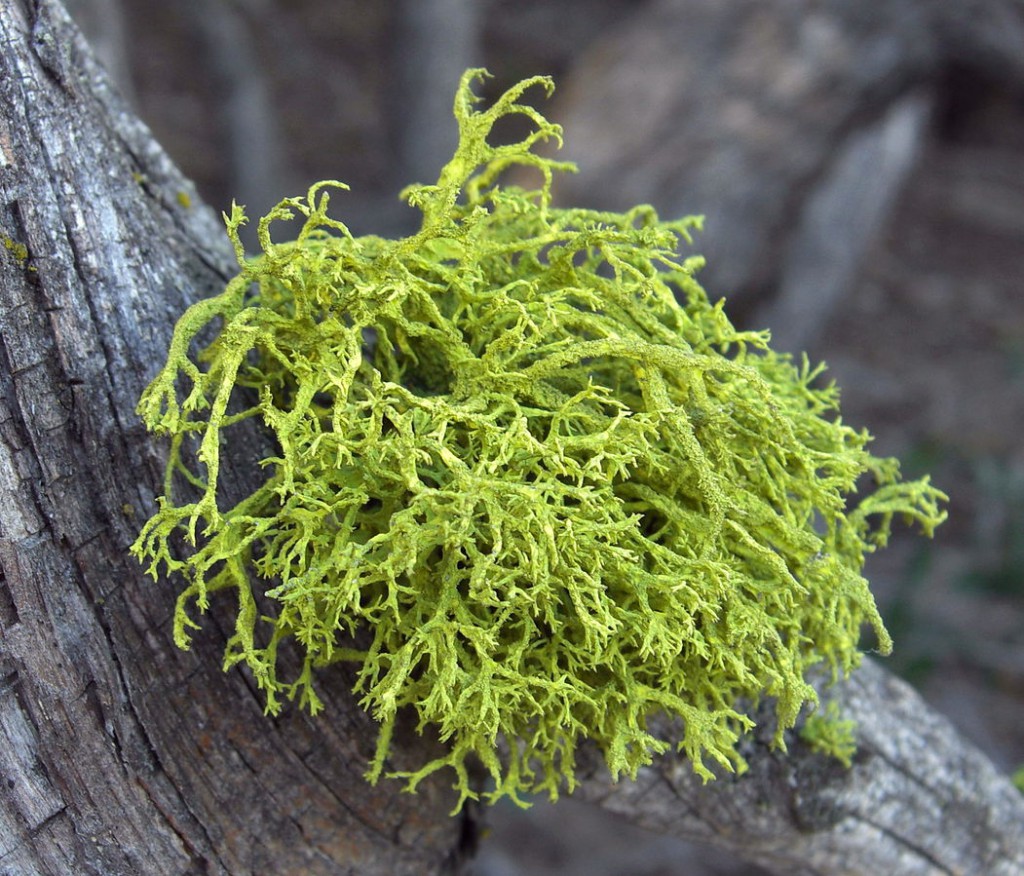For this month’s “Plant of the Month” article, we’ll be taking a closer look at a fascinating community of organisms that are living closely with plants throughout the ecosystem, however often overlooked – lichens. The following article describes how all lichens photosynthesize and like many plants, lichens depend on unique strategies to obtain the nutrients they need to exist. Enjoy learning all about lichens!
Article by Susan Bruneni

The lichen Letharia vulpina (L.) Hue photographed on Pseudotsuga macrocarpa and Calocedrus bark and wood in places with northern exposure. Location: Mt. Gleason, San Gabriel Mountains, Los Angeles Co., California, USA. Photo: Jason Hollinger
The next time you are out for a casual stroll in Santa Fe, take a closer look at any of the many rocks around town. The majority of larger rocks are home to a light gray faint green texturing with a somewhat lacy appearance. These are lichens and they can grow on rocks, trees, and in the soils of a wide array of environments and play a vital role.
A lichen is a composite organism that arises in a symbiotic relationship between an algae or cyanobacteria (or both) living among filaments of a fungus. This unique life form is unlike either organism of the symbiosis. Since fungus is the predominant partner, it gives the lichen the majority of its characteristics, from its thallus (twig-like) shape to its fruiting (spore producing) bodies. Lichens come in many colors, sizes, and forms.
Fungi depend on other organisms, such as algae in lichens, for nutrients since they do not contain chlorophyll or any other means of producing their own food. Fungi are vital for their role in the decomposition of organic matter. They are also necessary for the survival of the ecosystem around them, partnering with plants for nutrients and survival.
The lichen symbiotic partnership allows fungi to gain nutrients from another organism. Through photosynthesis, the algal partner and provides food for the fungus, so it can grow and spread. Fungi also provides water to the algae. Algae can survive in salt water and in freshwater on their own, and in any environment when part of a lichen relationship. Algae is a simple nonflowering plant lacking stems, roots and vascular tissue ranging in size from single-cell to massive seaweeds.

Dry soils containing cryptobiotic crusts (Photo: Annie Corbitt)
The lichen is usually described as having a leaflike (foliose), crusty (crustose), or branching shrublike (fruticose) form. Lichens often play an important part in the weathering of rocks. When lichens attach to rocks, they retain moisture and are instrumental in breaking rocks down. This is an essential component for producing soil in a barren environment, and obviously a very slow process.
We also see lichens in the cryptobiotic crusts of the soils of the Leonora Curtin Wetland Preserve. Especially along the drier upland trails (North and South trails), it is easy to spot a clumpy soil areas of the ground which is actually a layer which can include cyanobacteria, lichens, mosses, green algae, microfungi, and bacteria. This living biomass binds particles of soil, reduces erosion, fixes nitrogen, and can add organic matter. They are very fragile and even a footstep reduces their functioning which can take years (even decades!) to rebuild.
Lichens are widely used for many different purposes throughout the world. The most common use is dye production. Litmus paper is made from a dye mixture extracted from the Roccella species and applied to filter paper. Dyes used for clothing were used in the Scottish Highlands and produced red, orange, brown, and yellow. Purple dyes used throughout Europe from the 15ththrough 17thcenturies were extracted from lichens.
Many lichens have been used medicinally. A lichen’s usefulness as a medicine is often related to the lichen secondary compounds that are abundant in most lichen thalli. Different lichens produce a wide variety of these compounds, most of which are unique to lichens. It is estimated that 50-percent of all lichen species have antibiotic properties. Many lichen extracts have been found to be effective in killing the bacteria that cause boils, scarlet fever, and pneumonia.
One of the most potent lichen antibiotics is usnic acid, commonly used in traditional medicines. Usnea was used as a fungal remedy to treat the mouth, stomach, intestines, nose, ear, and skin. In Finland it was used to treat wounds, skin eruptions, and athlete’s foot. Elsewhere a preparation of the sodium salt of usnic acid was used to treat varicose and trophic ulcers, and second and third degree burns. It is still available from herbal suppliers.

Hikers in Leonora Curtin Wetland Preserve (Photo: Annie Corbitt)
Lichens have been and are still being used for many other purposes, including alcohol production (for flavor and preservatives) cosmetics, perfumes, fiber production, animal feed, tanning, insect repellent/insecticide and other applications.
So take a closer look at a wide world of vitality living on a rock near you. A magnifying glass might help see the complexity of what is there.
References:
US Forest Service, https://www.fs.fed.us/wildflowers/beauty/lichens
Lichens and mosses: Simple plants, The Taos News
Arizona State University, http://nhc.asu.edu/lherbarium/lichen_info/


